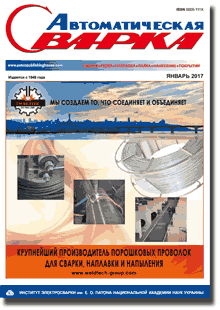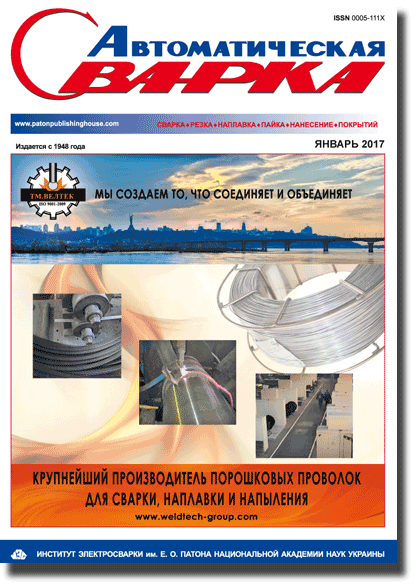| 2017 №01 (01) |
DOI of Article 10.15407/as2017.01.02 |
2017 №01 (03) |

Avtomaticheskaya Svarka (Automatic Welding), #1, 2017, pp. 19-25
Intensification of arc and electroslag processes of welding by means of exothermal mixture introduction
A.F. Vlasov, N.A. Makarenko and D.A. Volkov
Donbass State Machine-Building Academy 72 Shkadinov Str., 84313, Kramatorsk, Ukraine. E-mail:sp@dgma/donetsk.ua
Abstract
It is proved that introduction of up to 53.4 % of exothermal mixture in electrode coating results in increase of the following coefficients, i.e. core melting, deposition, rate of electrode melting and melting of electrode coating. Increase of thickness of electrode coating, containing 44.4 % of exothermal mixture, from 0.5 to 2.6 mm results in rise of amount of exothermal mixture and deposition coefficient, decrease of value of core melting coefficient, increase of mass rate of coating melting. It is proved that an efficient method for increase of electroslag processes efficiency is application of exothermal flux, namely scale, ferroalloys, aluminum powder and standard flux (ANF-6 etc.) in the amounts sufficient for exothermal reaction passing. This provides for emission of additional heat in a start period of exothermal processes and promotes for accelerated formation of slag pool of necessary volume on «solid» start on monofilar as well as bifilar schemes of process instead of «liquid» start. The electroslag processes using exothermal alloyed flux on «solid» start allow (in comparison with existing methods of slag pool formation) rising metal yield by 2–10 %; 1.2–1.4 kW?h economy of melting of 1 kg of standard flux; 25 % reduction of time of ESR process start period. It is determined that introduction of aluminum as a deoxidizing agent in the exothermal fluxes rises content of aluminum oxide (Al2O3) in a weld pool, its resistance, and increases efficiency of electroslag process. 21 Ref., 5 Figures.
Keywords: electrode, exothermal mixture, exothermal flux, slag pool, process efficiency
Received: 16.02.17
Published: 26.10.16
References
- Mazur, A.A., Pustovojt, S.V., Petruk, V.S. et al. (2014) Ukrainian market of welding consumables. The Paton Welding J., 6/7, 46–52. https://doi.org/10.15407/tpwj2014.06.09
- Doria, J.G. (2001) Welding consumables: Market trends. Istanbul: European Welding Association.
- Nassau, L. van (2001) Expert report stick electrodes 2000: Stick electrodes. Istanbul: European Welding Association.
- (1998) Materials and applications: Welding handbook. Miami, USA, Vol. 4, Pt 2.
- Shlepakov, V.N. (2011) Current consumables and methods of fusion arc welding (Review). The Paton Welding J., 10, 26–29.
- (2011) Welding consumables. In: Coll. of papers in The Paton Welding J. for 2006–2010. Comp. by V.N. Lipodaev. Kiev: PWI.
- (2012) Metallurgy of arc welding and welding consumables: Collect. of NASU, PWI. Comp. by I.K. Pokhodnya, A.S. Kotelchuk. Kiev: Akademperiodika.
- Pokhodnya, I.K. (2003) Welding consumables: State-of-the-art and tendencies of development. The Paton Welding J., 3, 2–13.
- Ioffe, I.S., Kuznetsov, O.M., Pitersky, V.M. (1980) Effect of titanium thermite mixture in electrode coating on increase of welding efficiency. Proizvodstvo, 3, 26–28.
- Karpenko, V.M., Vlasov, A.F., Bilyk, G.B. (1980) Indices of melting of welding electrodes with exothermal mixture in coating. Proizvodstvo, 9, 23–25.
- Vlasov, A.F., Makarenko, N.A., Kushchy, A.M. (2014) Heating and melting of electrodes with exothermic mixture in coating. The Paton Welding J., 6/7, 147–150. https://doi.org/10.15407/tpwj2014.06.32
- Chigarev, V.V., Zarechensky, D.A. (2006) Examination of indices of exothermal mixtures burning. Visnyk Pryazov. DTU, 1–4.
- Chigarev, V.V., Zarechensky, D.A., Belik, A.G. (2007) Peculiarities of melting of flux-cored strips with esothermic mixtures contained in their filler. The Paton Welding J., 2, 46–48.
- Zarechensky, A.V., Leshchinsky, L.K., Chigarev, V.V. (1985) Peculiarities of melting of flux-cored strips with exothermal mixtures. Proizvodstvo, 8, 39–41.
- Vlasov, A.F., Karpenko, V.M., Leshchenko, A.I. (2006) Experimental determination of exothermic process in heating and melting of electrodes. Visnyk Donbas. Mashyn. Akademii, 4(2), 65–68.
- Latash, Yu.V., Medovar, B.I. (1970) Electroslag remelting. Kiev: Metallurgiya.
- Makarenko, N.A., Vlasov, A.F., Volkov, D.A. et al. (2015) Study and development of composition of exothermic fluxes for electroslag processes. Sovremennaya Elektrometallurgiya, 2, 10–16. https://doi.org/10.15407/sem2015.02.02
- Vlasov, A.F., Makarenko, N.A., Kushchy, A.M. (2016) Application of exothermal mixtures in manual arc welding and electroslag processes. Proizvodstvo, 8, 7–14.
- Vlasov, A.F., Kushchy, A.M. (2011) Technological characteristics of electrodes with exothermal mixture in coating for surfacing of tool steels. Ibid., 4, 10–15.
The cost of subscription/purchase order journals or individual articles
| Journal/Currency | Annual Set | 1 issue printed |
1 issue |
one article |
| TPWJ/USD | 384 $ | 32 $ | 26 $ | 13 $ |
| TPWJ/EUR | 348 € | 29 € | 24 € | 12 € |
| TPWJ/UAH | 7200 UAH | 600 UAH | 600 UAH | 280 UAH |
| AS/UAH | 1800 UAH | 300 UAH | 300 UAH | 150 UAH |
| AS/USD | 192 $ | 32 $ | 26 $ | 13 $ |
| AS/EUR | 180 € | 30 € | 25 € | 12 € |
| SEM/UAH | 1200 UAH | 300 UAH | 300 UAH | 150 UAH |
| SEM/USD | 128 $ | 32 $ | 26 $ | 13 $ |
| SEM/EUR | 120 € | 30 € | 25 € | 12 € |
| TDNK/UAH | 1200 UAH | 300 UAH | 300 UAH | 150 UAH |
| TDNK/USD | 128 $ | 32 $ | 26 $ | 13 $ |
| TDNK/EUR | 120 € | 30 € | 25 € | 15 € |
AS = «Automatic Welding» - 6 issues per year;
TPWJ = «PATON WELDING JOURNAL» - 12 issues per year;
SEM = «Electrometallurgy Today» - 4 issues per year;
TDNK = «Technical Diagnostics and Non-Destructive Testing» - 4 issues per year.





